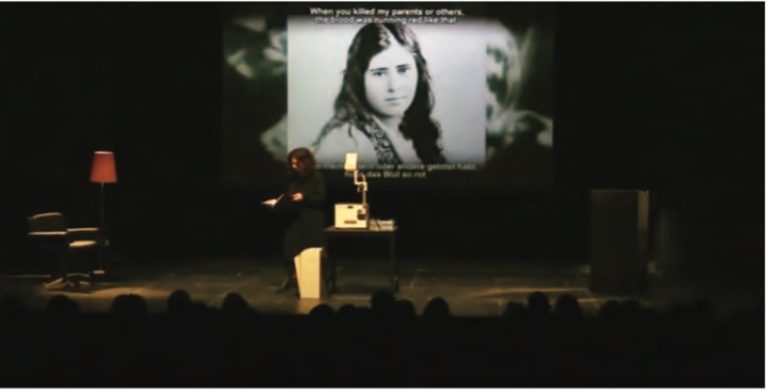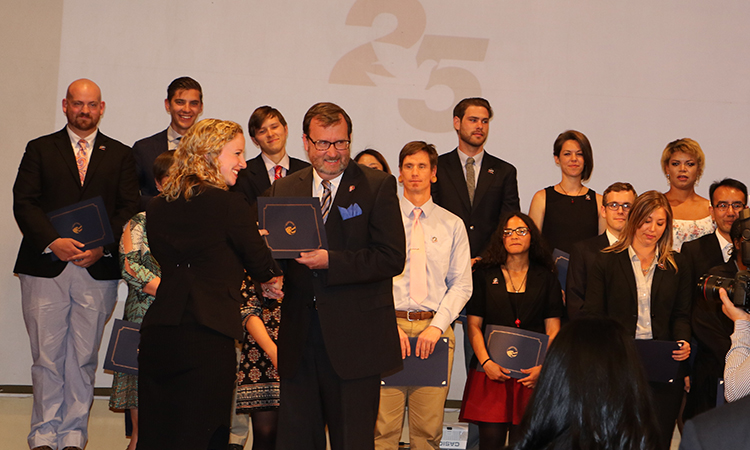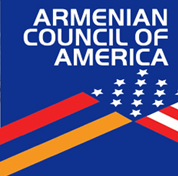FRESNO — The Society for Armenian Studies announces the release of Volume 28, Issue 2 (Fall 2022) of the Journal of the Society for Armenian Studies (JSAS), edited by Dr. Tamar M. Boyadjian (Michigan State University), the Editor-in-Chief, and Dr. Rachel Goshgarian (Lafayette College), the Reviews and Reconsiderations editor on the theme of Armenian women in theater, cinema, and music.
“Performance II builds on themes of reticulated networks in the performing arts, while at the same time challenging the traditional models of how performance has been evaluated in the past. The contributions in this volume make intentional efforts to re-qualify the registers and frameworks in which the questions around performance and memory, identity, and the body – particularly the female body – have been previously analyzed,” wrote Boyadjian.
Under the title Performance, Memory, and the Archive, the volume begins with a conversation with Arsineé Khanjian, detailing how performances can open avenues for thoughts on memory and archive, Armenianness, cultural and diasporic identity, the female body, and political engagement. Khanjian’s Auctions of Souls. Performing Memory, is based on the life of Armenian genocide survivor and American early cinema actress, Aurora Mardiganian, who Khanjian successfully highlights in a “idiosyncratic artistic approach” by using images, scenes and passages from multiple sources. Khanjian argues the performance’s contemporary relevance by showcasing how the context of the Armenian genocide continues to present itself in current social, ethical, and geopolitical issues present today.
The conversation is followed by the section titled Between Activism & Authoriship: Thoughts & Translations on Zabel Yesayan. The first article in this section by Talar Chahinian is titled Zabel Yesayan: The Myth of the Armenian Transnational Moment. Chahinian follows a collection of think-pieces that intersect with “dual performative acts of iconification and translation,” which frame the approach to understanding Yesayan in the last several decades. The collection of thoughts and translations, search to find and define Yesayan as a writer, activist, and feminist amongst contemporary debates while “ultimately guiding the reader back to her own words.”
The second article, So, Did We Really Find Yesayan? Notes on “Yesayan Studies” and Beyond by Maral Aktokmakyan examines problematic interest in the work of Zabel Yesayan and the broader question surrounding the fate of Armenian literary studies and criticism. Aktokmakyan argues that the growing craze for “feminist Yesayan” has a problematic reductive and teleological approach, which nearly disregards Yesayan’s work. Instead, Aktokmakyan promotes a “rhizomatic reading that would liberate the author from overloaded feminist and genocide-based readings.”
The third piece by Meriam Belli is titled Zabel Yesayan, “Chronicle – The Role of the Armenian Woman during the War.” It is a translation of French lecture delivered by Yesayan on January 17, 1920. Originally published in the French Revue des Études Arméniennes 2 (1922): 121–138, describing the banishment of Armenians from their homelands, the crimes that were perpetuated against them, and their resilience and strength. In addition, the translation focuses on gendered violence against women during the genocide and the display of their moral attributes, including their strength and national dignity during the war.
The fourth and final piece by Elyse Semerdjian is titled The Liberation of non-Muslim Women and Children in Turkey: Notes on the Question of the Abduction of non-Muslim Women and Children by the Turks, Retained until Today by Muslims By Zabel Essayan. This is an annotated translation of Yesayan’s report that explores how the Ottoman government and its proxies targeted women and children with specific forms of genocidal violence. The report provides an in-depth analysis of the specific forms of sexual atrocity central to genocidal design and details how women in the diaspora should organize to help what she called, “the International Commission of Women.” Genocidaires were successful in unraveling communities because they could weaponize patriarchal notions of the family and proprietorship over women’s sexuality to achieve their ends, thereby making the gender aspect of genocidal violence a central part of the design.
The section on Translations and Thoughts on Zabel Yesayan’s work is followed by a section on Armenian Theater in Istanbul. The first article Reflections on the Legacy of 19th-century Istanbul Armenian Theater Projects in the Contexts of Ottomanism and Turkishness is by Ayşan Sönmez. The article details, “how the Ottoman Armenian theatrical experience became a legacy that was able to serve a budding Armenian nationalism, the idea of a shared Ottomanism during a specific time, and, eventually, to bolstering Turkishness as the Empire evolved into a nation-state.” The reflections of all socio-political and economic developments of the Ottoman Empire during the 19th and 20th century could be found intertwined with the modern Armenian theatre.
Transitioning to premodern sculpting and performance, The Medieval Armenian Symbol of Eternity in the Art of the Twelfth-Century Italian Sculptor Nicholaus: A Veiled Performance by Lorenzo Dominioni and Antranik Balian, examine the medieval Armenian symbol of eternity or the whirl sign engraved in the forehead of five bull sculptures dating to the first half of the 12th century, and attributed to the Italian sculptor Nicholaus. Dominioni and Balian argue that the engravings found “in the bull head of Koenigslutter, Carpi, Ferrara and Verona were a veiled ornamental performance displaying the symbol of eternity to signify the concept of life in the hereafter.” The symbol being deeply rooted in Armenian Christian art and foreign to Italian religious decorations leads them to conclude that Nicholaus’ inspirational source was likely Armenian.
The section on Reviews and Reconsiderations starts with a conversation followed by two book reviews. Titled “Performing the Premodern in The Color of Pomegranates, Imagining and Communicating the Past” is a conversation between Galina Tirnanić and Nicolas Trépanier, moderated by Rachel Goshgarian. The conversation deals with Sergei Parajanov’s Color of Pomegranates (1969). The discussants look to “re-imagine the film as a potential point of initiation for new approaches to reading, imagining, teaching, and writing about the medieval world, both within and beyond Armenian contexts.”
Following the conversation piece is a book review by Nazan Maksudyan of Takyhi Tovmasyan’s, Word, Voice, Taste: Takuhi Tovmasyan’s, Reflections on Sofranız Şen Olsun: Ninelerimin Mutfağından Damağımda, Aklımda Kalanlar (Cheer to Your Table: Tastes from my Grandmother’s Kitchen that Have Remained in my Mouth and my Mind. The combined cookbook and memoir explore a collection of more than thirty dishes, characters, and stories depicting a precious past. Maksudyan details Tovmasyan’s stories with great intensity as she explores the shared “secrets about the word that remains, the voice that sings, and the taste that heals.”
Bedross Der Matossian reviews Armen T. Marsoobian’s Reimagining a Lost Armenian Home: The Dildilian Photography Collection. In this review Der Matossian captures the uniqueness and rarity of the Dildilian family’s ability to preserve their family history through photographs during war, deportation, and genocide. He highlights the family’s influential success and the book’s ability to take the reader through a journey in time and space by portraying the daily lives of Armenians in the Ottoman Empire. Der Matossian argues that the history of the Dildilian family, “provides a microcosm of better understanding how some Armenian families were able to use their skills in order to survive the genocide against all odds – a common thread among Armenian oral history testimonies of the period.”
Commenting on this issue Der Matossian, the President of the Society for Armenian Studies said: “I would like to congratulate Dr. Tamar Boyadjian, the Editor-in-Chief and Dr. Rachel Goshgarian, the Reviews and Reconsiderations editor for putting together such an exquisite volume on the theme of performance. The depths as well as the insights presented in these articles are breathtaking. JSAS is receiving global recognition in the field of Armenian Studies. It has become one of the most prestigious journals in the field that is able to initiate dialogue on thematic as well as interdisciplinary topics.”
Tamar M. Boyadjian, Michigan State Uniersity, continues as the Editor-in-chief. The Reviews and Reconsiderations Editor was Rachel Goshgarian, Lafayette College. The Advisory Board consists of: Bedross Der Matossian, University of Nebraska-Lincoln; Barlow Der Mugrdechian, California State University, Fresno; Sergio La Porta, California State University Fresno; Sharon Kinoshita, University of California, Santa Cruz; Jyotsna Singh, Michigan State University; and Alison Vacca, Columbia University.The Editorial Board consists of: Sebouh Aslanian, University of California; Stephan Astourian, University of California, Berkeley; Marie-Aude Baronian, Universiteit van Amsterdam; Houri Berberian, University of California, Irvine; Talar Chahinian, University of California, Irvine; Hratch Tchilingirian, University of Oxford; Myrna Douzjian, University of California, Berkeley; Shushan Karapetian, University of Southern California; David Kazanjian, University of Pennsylvania; Lilit Keshishyan, University of Southern California; Tsolin Nalbantian, Universiteit Leiden; Christina Maranci, Tufts University; Elyse Semerdjian, Whitman College; and Heghnar Watenpaugh, University of California, Davis.
The table of contents for JSAS 28 (2) can be accessed at: https://brill.com/view/journals/jsas/28/2/jsas.28.issue-2.xml










